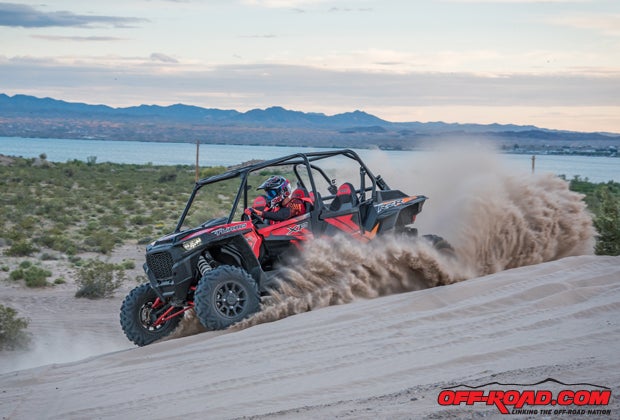
Polaris and their RZR lineup of sport-infused UTVs has been enjoying undaunted success for almost the past 10 years. In 2008, the RZR platform debuted to much acclaim and industry adoration, and ever since then they have been innovating and expanding the RZR lineup to successfully outsell every competitor that has arisen.
The market has changed drastically in the past several years, namely with new competitors from Can-Am, Yamaha, Arctic Cat, and several import brands. Even with all of the competition, Polaris is still reeling in the sales. Is the 2017 RZR lineup, especially their top-of-the-line XP 4 Turbo that you see here, good enough to keep the U.S. manufacturer at the top of the heap? Or is their reign as champions of the sport Side-X-Side industry in jeopardy? Letís take a look at this vehicle and see what itís all about first.
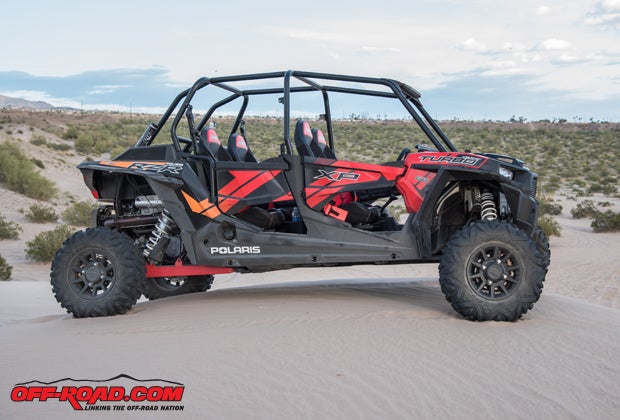
For 2017, the XP 4 Turbo went under the knife, but the only real cosmetic changes youíll notice are the larger front fascia opening for the radiator, the new gauge cluster for the interior, and the larger air intakes sitting on top of the rear haunches of the vehicle. The rest of the changes are under the skin. For instance, the engine and transmission have both been strengthened with forged parts for increased efficiency and strength under load. Oh, by the way, the increased load comes from the increase in power Ė 168 horsepower to be exact! Yes, that now leads the pack in the industry, again.
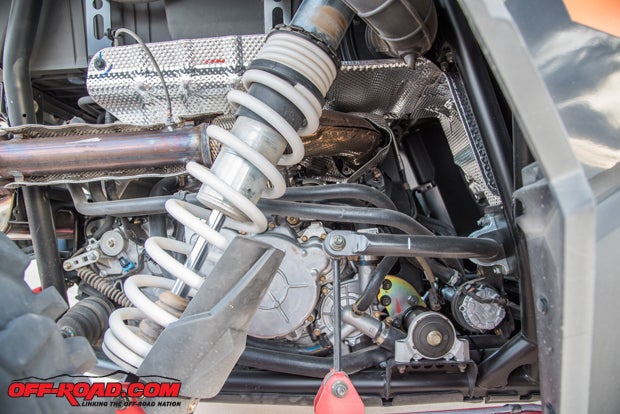
To combat overheating issues, Polaris increased the radiator size by 20 percent, and they also added a more efficient brushless radiator fan. On another cooling note, both the belt and engine air intakes in the back have drastically increased airflow over last year. Last but certainly not least, one of the changes we are most excited about is the steering change Ė it now features a 1.5 turn steering rack that quickens the steering and makes it even more precise than before.
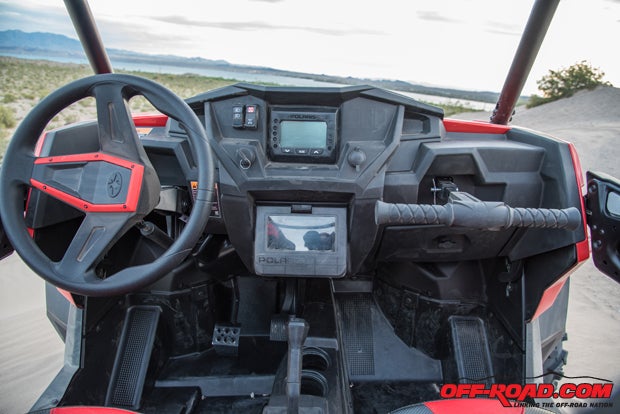
When you step into the cockpit of the XP4 Turbo youíll first notice that nothing much has changed besides that new digital instrument cluster. Do we like it more than last yearís analog speedo readout and digital display? We arenít convinced itís that much better, if any better, but we do like the fact that there are more spots for auxiliary switches in the instrument panel now. For those who want to add accessories to their ride this feature is key.
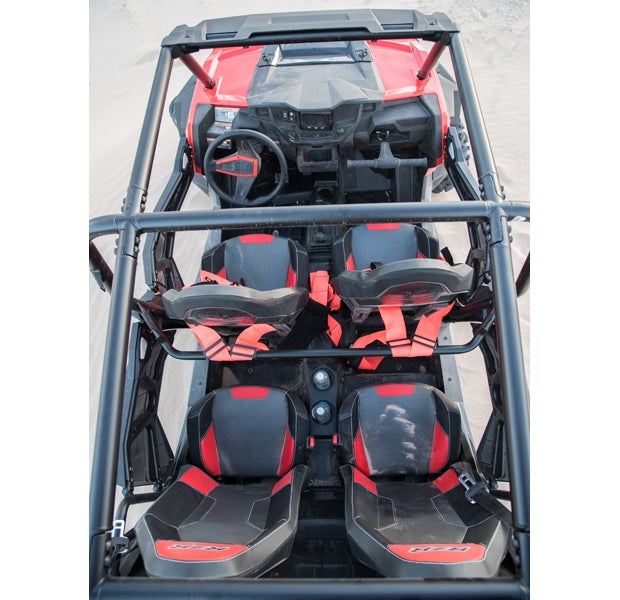
Other than that, riders still get four cup holders in total, a deep glove box and a center storage section/phone holder. While still comfortable and supportive, the RZR lineup would benefit from a revised seating arrangement that has built-in four-point slots in the seats, more lateral support and stronger seat bases so you donít move around while driving.
In addition, it would be great to have a longer bottom seat cushion that offers more support for your legs when traversing rough terrain. For backseat passengers, anyone over 6 feet will find their knees straddling the front seats. More room would be a welcome addition back here as well, but the wheelbase stretch to accommodate such a request would alter the overall handling.
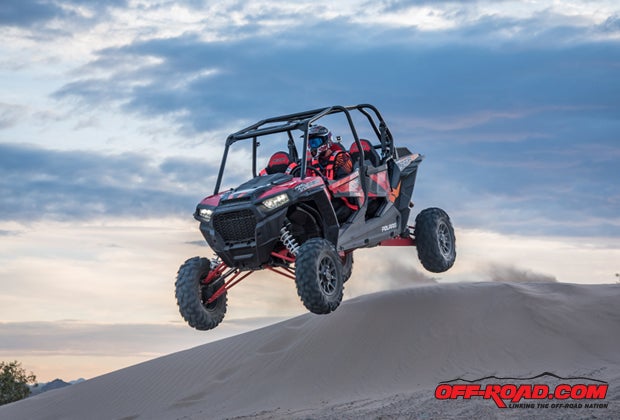
Speaking of handling, driving the XP 4 Turbo is a visceral experience Ė thrilling, exuberant and fast are just a few words that describe the experience! The first thing we notice is the 168 horsepower. Throw your foot down and wham! The back of the seat holds you into place but is fighting the massive acceleration tendencies of this machine. With a dry weight of only 1691 lbs., driverís can utilize all of the 168 horsepower. And, you want to know what surprises us the most? Itís the fact that this Polaris powerplant has such a domestic side to it as well. Are you more of a family who likes to cruise 90 percent of the time and then go for an adrenaline-filled ride once a weekend? The turbo motor is great for all of that with a powerband that doesnít intimidate unless you unleash all of the ponies.
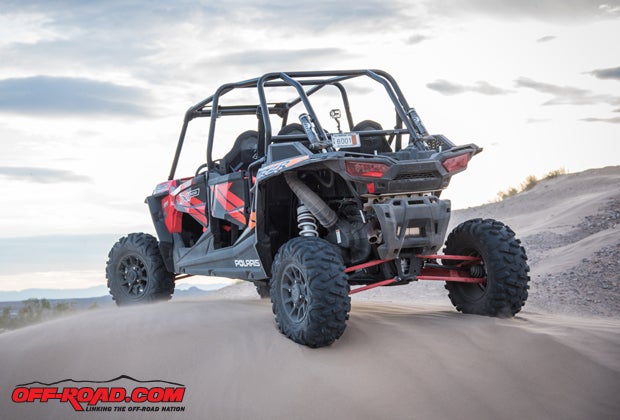
Now that the Turbo model has enjoyed a year under its belt and revisions for 2017, we can confidently say the clutching has made a positive change year over year, and it is virtually spot on with the stock setup now. Shifting through the gears is effortless and has positive engagement. Power delivery to the rear wheels or to all four wheels in 4WD is smooth, precise, and it feels like the engine is directly connected to the wheels Ė the power transfer is effortless, and we feel like Polaris has mastered this feeling and camaraderie between the machine and driver. Kudos, guys!
The only thing we would like to see is more bite from the tires. The power of this machine overwhelms the stock Maxxis Bighorn 2.0ís easily, but it doesnít take away from the fact that these tires are still one of the best all-around meats in the business with the ability to run hard in sand, rocks, and dirt.
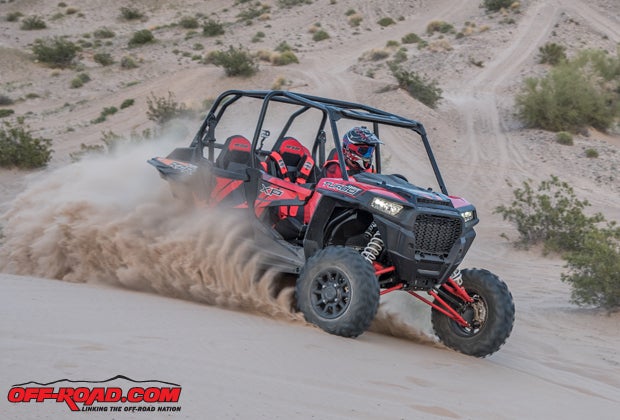
The XP 4 Turbo chassis is still one of the most fun setups to drive on the market Ė if not THE most fun! While not as easy to throw around as the two-seat XP Turbo, the four-seater is still able to rail around corners. The chassis needs to be hustled around turns because it sits up higher, but the back end can be swung out with impeccable control. Overall, the chassis is predictable, and we would choose to lower it slightly compared to stock to get even more control out of it.
Overall, the power and chassis is incredible in the XP 4 Turbo package. Yes, it could use some refinement, but weíll see what Polaris does with the 2018 model year of machines. Until then, the XP 4 Turbo is an incredible machine in stock form. It gets your family out to the desert to ride and have an absolute blast, and it has immense potential in the customization department. In other words, you canít go wrong with this machine. The MSRP for the XP 4 Turbo starts at $27,499.
MORE UTV STORIES
2017 UTV World Championship Coverage, Results


 Your Privacy Choices
Your Privacy Choices